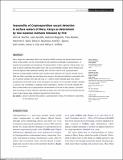| dc.contributor.author | Muchiri, John M. | |
| dc.contributor.author | Ascolillo, Luke | |
| dc.contributor.author | Mutuma, Mugambi | |
| dc.contributor.author | Mutwir, Titus | |
| dc.contributor.author | Ward, Honorine D. | |
| dc.contributor.author | Naumova, Elena N. | |
| dc.contributor.author | Egorov, Andrey I. | |
| dc.contributor.author | Cohen, Seth | |
| dc.contributor.author | Else, James G. | |
| dc.contributor.author | Griffiths, Jeffrey K. | |
| dc.date.accessioned | 2019-06-07T13:47:26Z | |
| dc.date.available | 2019-06-07T13:47:26Z | |
| dc.date.issued | 2008-10 | |
| dc.identifier.uri | https://doi.org/10.2166/wh.2009.109 | |
| dc.identifier.uri | http://repository.kemu.ac.ke:8080/xmlui/handle/123456789/377 | |
| dc.description.abstract | Meru, Kenya has watersheds which are shared by wildlife, humans and domesticated animals. These surface waters can be contaminated by the waterborne pathogen Cryptosporidium. To quantify the seasonality and prevalence of Cryptosporidium in Meru regional surface waters, we used a calcium carbonate flocculation (CCF) and sucrose floatation method, and a filtration and immunomagnetic bead separation method, each of which used PCR for Cryptosporidium detection and genotyping. Monthly water samples were collected from January through June in 2003 and 2004, bracketing two April-May rainy seasons. We detected significant seasonality with 8 of 9 positive samples from May and June (p<0.0014), which followed peak rainy season precipitation and includes some of the subsequent dry season. Six of 9 positive samples revealed C. parvum, and 3 contained C. andersoni. None contained C. hominis. Our results indicate that Meru surface waters are Cryptosporidium-contaminated at the end of rainy seasons, consistent with the timing of human infections reported by others from East Africa and contrasting with the onset of rainy season peak incidence reported from West Africa. | en_US |
| dc.language.iso | en | en_US |
| dc.publisher | Journal of Water and Health | | en_US |
| dc.relation.ispartofseries | J Water Health (2008) vol 7;issue 1 | |
| dc.subject | Cryptosporidium | en_US |
| dc.subject | calcium carbonate flocculation, | en_US |
| dc.title | Seasonality of Cryptosporidium oocyst detection in surface waters of Meru, Kenya as determined by two isolation methods followed by PCR | en_US |
| dc.type | Article | en_US |

